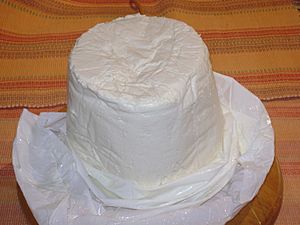Anthotyros facts for kids
Quick facts for kids Anthotyros |
|
|---|---|

A block of anthotyros, lying on top of its protective paper covering
|
|
| Country of origin | Greece |
| Source of milk | Goats, Ewes |
| Pasteurized | Not traditionally, but commercially yes |
| Texture | Hard (Dry) / Soft (Fresh) |
| Fat content | 16.6% 65.9% |
| Protein content | 9.6% |
| Dimensions | various |
| Weight | various, usually 1/2 or 1 kilo |
| Aging time | 10 Days |
| Named after | Lua error in Module:Wikidata at line 70: attempt to index field 'wikibase' (a nil value). |
Anthotyros (pronounced "an-tho-TEE-ros") is a special kind of traditional Greek cheese. Its name means "flowery cheese" in Greek! This cheese can be found in two main types: fresh and dry. It's made using milk and a liquid called whey, usually from sheep or goats, or sometimes a mix of both.
Contents
What is Anthotyros Cheese?
Anthotyros is a very old type of cheese from Greece. It's known for its unique taste and how it's made. The fresh version is soft and creamy, while the dry version is harder and more salty.
The "Flowery" Name
The name "Anthotyros" comes from Greek words meaning "flower" and "cheese." Some people think it's called this because of its delicate, sweet taste, like flowers. Others believe it's because of the way it looks when it's being made.
What is Whey?
Whey is the watery part of milk that separates from the solid curds when cheese is made. It's full of nutrients and is often used to make other types of cheese, like Anthotyros. For Anthotyros, cheesemakers usually use a lot more milk than whey, about nine parts milk to one part whey.
How is Anthotyros Made?
Making Anthotyros is a careful process that has been passed down for generations. It involves several steps to turn milk and whey into this delicious cheese.
Cooking the Milk
First, the milk is gently heated for about ten minutes. Then, a special ingredient called rennet is added. Rennet helps the milk thicken and form curds. Salt is also added at this stage. The mixture is stirred gently while this happens.
Draining the Cheese
After the milk thickens, it's left in large, shallow containers. The next day, more salt is added. The cheese mixture is then carefully poured into a special basket lined with a fine cloth, like tulle. This allows the extra liquid to drain away. Salt is added every day for about three or four more days. At this point, the cheese is still fresh and soft.
Aging for Dry Anthotyros
If the cheese is going to be the dry version, it's left to age even longer. During this time, thick salt is often put on the outside of the cheese. This helps it dry out and become harder and more flavorful.
Fresh vs. Dry Anthotyros
Anthotyros comes in two main forms, and each has its own special qualities and uses.
Fresh Anthotyros
The fresh version of Anthotyros is usually dry, white, and can be soft or medium-hard. It has a sweet, creamy taste and doesn't have a hard outer rind. It also doesn't have much salt.
- How to eat it: People often enjoy fresh Anthotyros for breakfast with honey and fruit. It can also be used in savory dishes with olive oil, tomato, and wild herbs.
Dry Anthotyros
The dry version is hard, very dry, white, and salty. It can sometimes have a strong smell, a bit like sherry.
- How to eat it: Dry Anthotyros is often grated or crumbled over dishes. It's delicious on spaghetti or sprinkled over fresh salads.
Where is Anthotyros Found?
Anthotyros cheese is a popular food throughout Greece. It's made in many different regions, each adding its own local touch to the cheese. You can find it commonly produced in areas like Thrace, Macedonia, the Ionian Islands, and Crete.
See also
 In Spanish: Anthotiros para niños
In Spanish: Anthotiros para niños

